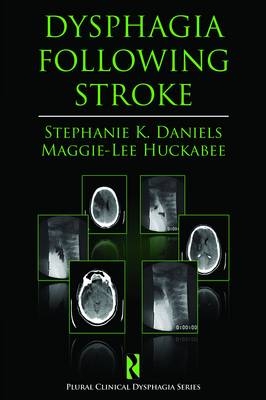
Dysphagia Following Stroke
Plural Publishing Inc (Verlag)
978-1-59756-196-9 (ISBN)
- Titel ist leider vergriffen;
keine Neuauflage - Artikel merken
Stephanie Daniels, Ph.D. Research Speech Pathologist Michael E. DeBakey Veterans Affairs Medical Center, Houston, Texas Assistant Professor, Department of Physical Medicine and Rehabilitation, Baylor College of Medicine Stephanie K. Daniels, Ph.D. is a research speech pathologist at the Michael E. DeBakey Veterans Affairs Medical Center in Houston, Texas and is Assistant Professor in the Department of Physical Medicine and Rehabilitation at the Baylor College of Medicine. Prior to obtaining her doctorate, she was a practicing clinician for twelve years. Her research and clinical work has focused on neurogenic dysphagia. Maggie-Lee Huckabee, Ph.D. Senior Lecturer Department of Communication Disorders, University of Canterbury Senior Researcher Van der Veer Institute for Parkinson's and Brain Research in Christchurch, New Zealand Maggie-Lee Huckabee, Ph.D., practiced as a clinician for thirteen years before the frustration of never knowing "the answers" led her to an academic career. She is now senior lecturer in the Department of Communication Disorders, University of Canterbury and senior researcher at the Van der Veer Institute for Parkinson's and Brain Research in Christchurch, New Zealand. She still hasn't found "the answers" but is trying, with research interests focusing on the complexities of behaviorally-driven neural adaptation and biomechanical change leading to swallowing recovery. Dr. Huckabee has a great time supervising terrific, emerging researchers, overseeing a busy laboratory and enjoying the beauty of New Zealand.
Foreword by Jay Rosenbek, PhD Chapter 1: Introduction to Dysphagia and Stroke Overview of Stroke Dysphagia in Stroke Multidisciplinary Management of Dysphagia in Stroke Chapter 2: The Neural Control of Swallowing: From Central to Peripheral Methods for Understanding Neural Control Higher Nervous System Control Central Pattern Generator/Brainstem Mechanisms Peripheral Neuromuscular Mechanisms Chapter 3: Normal Swallowing Anatomy and Physiology Defining Normal and Abnormal Swallowing Phases of Swallowing Chapter 4: The Clinical Swallowing Examination: History and Patient Interview Patient History Patient and Family Interview Chapter 5: The Clinical Swallowing Examination: Cognition and Communication Assessments The Cognitive Assessment The Communication Assessment Chapter 6: The Clinical Swallowing Examination: The Evaluation of the Oral Mechanism Structural Integrity The Cranial Nerve Examination: Inferring Physiology Case Example Chapter 7: The Clinical Examination of Swallowing: Assessment of Oral Intake Executing the Assessment of Oral Intake Interpreting the Assessment of Oral Intake Chapter 8: The Clinical Swallowing Examination: Predicting Dysphagia and Aspiration The Water Swallow Test The CSE with a Focus on Clinical Features Predicting Dysphagia and Aspiration The Mann Assessment of Swallowing Ability Chapter 9: Adjuncts to the Clinical Swallowing Examination Pulse Oximetry Cervical Auscultation Cough Reflex Testing Chapter 10: The Instrumental Examination: The Videofluoroscopic Swallow Study The Need for Diagnostic Specificity Chapter 11: The Instrumental Swallowing Examination: Evaluation of Swallowing Respiratory Coordination - An Auxiliary to the Videofluoroscopic Swallow Study Executing the Evaluaton of Swallowing Repiratory Coordination Interpreting the Evaluaton of Swallowing Repiratory Coordination Chapter 12: The Instrumental Swallowing Examination: Videoendoscopic Evaluation of Swallowing Executing the Videoendoscopic Evaluation of Swallowing Interpreting the Videoendoscopic Evaluation of Swallowing Chapter 13: The Instrumental Swallowing Examination: Manometric Evaluation of Swallowing Executing the Manometric Evluation Interpreting the Manometric Evaluatin Variables Influencing Pharyngeal Pressure Measurement What Can Manometry Offer to Clinical Practice? Case Examples Chapter 14: Professional Responsibilities:Dysphagia Diagnosis in Stroke Case Example Chapter 15: Diagnosis of Dysphagia in Stroke Oral Phase Pharyngeal Phase Oral and Pharyngeal Dysmotility in Stroke Chapter 16: Diet Considerations: To Feed or Not to Feed **An Overview of Options for Feeding the Dysphagic Patient **Non-Oral, Enteral Feeding Options Decision Making for Non-Oral Nutrition Free Water Chapter 17: Compensatory Management Postural Changes Sensory Enhancement Volitional Control of Oral Transfer Breath-Holding Techniques Bolus Modification Chapter 18: Rehabilitation of Oropharyngeal Dysphagia Oral Motor Exercises Effortful Swallow Mendelsohn Maneuver Masako Maneuver (Tongue-Hold Maneuver) Head-Lift Exercise Chapter 19: Maximizing Rehabilitation Effectiveness Biofeedback Modalities in Dysphagia Rehabilitation Dose Chapter 20: Emerging Modalities in Dysphagia Management Expiratory Muscle Strength Training Neuromuscular Electrical Stimulation The Need for Intelligent Enthusiasm Chapter 21: Medical and Surgical Management Medical Management Surgical Intervention Chapter 22: Lagniappe Management Effectiveness with Stroke Patients Reassessment Last Thoughts References Index
| Erscheint lt. Verlag | 30.6.2008 |
|---|---|
| Zusatzinfo | b/w illustrations |
| Verlagsort | San Diego |
| Sprache | englisch |
| Maße | 200 x 127 mm |
| Themenwelt | Medizin / Pharmazie ► Gesundheitsfachberufe ► Logopädie |
| ISBN-10 | 1-59756-196-7 / 1597561967 |
| ISBN-13 | 978-1-59756-196-9 / 9781597561969 |
| Zustand | Neuware |
| Haben Sie eine Frage zum Produkt? |
aus dem Bereich


